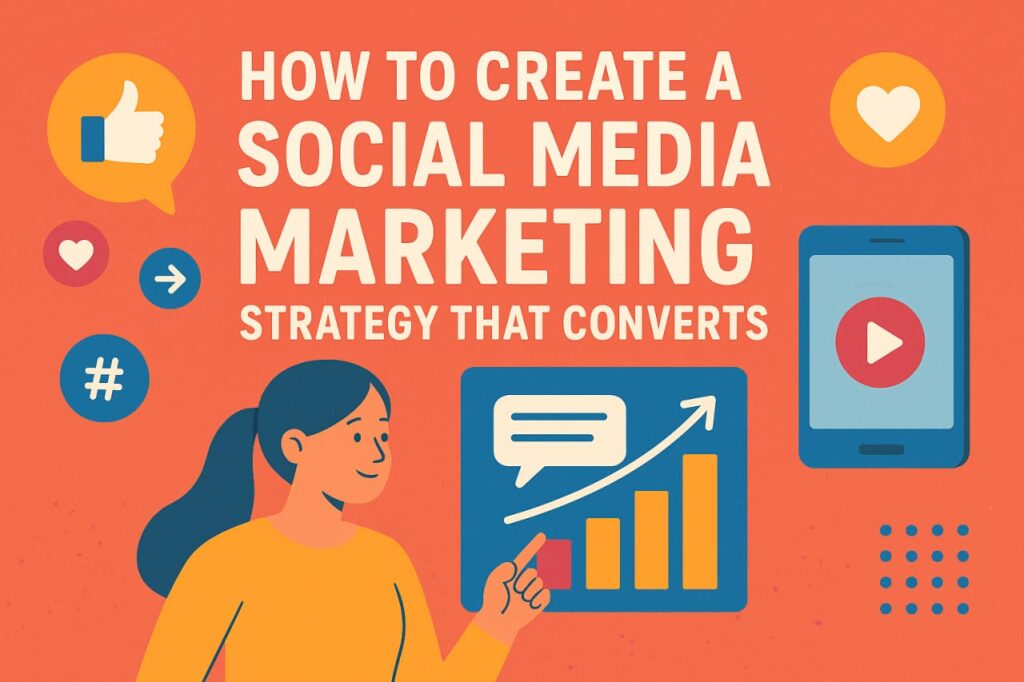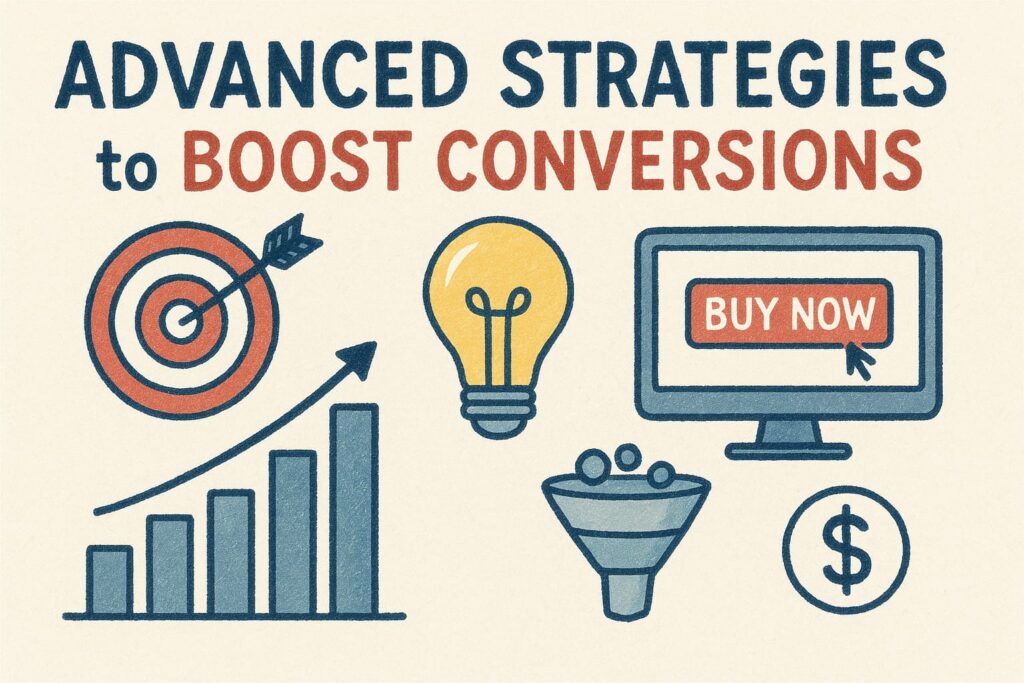How to Create a Social Media Marketing Strategy That Converts
Build a Social Media Marketing Strategy that works. Learn practical techniques for audience targeting, content planning, automation, and analytics to turn followers into loyal customers.

Social media is one of the most powerful tools for businesses today. But posting randomly without a plan won’t bring results. To generate leads, boost engagement, and increase sales, you need a clear Social Media Marketing Strategy.
This guide will walk you through step by step to create a strategy that converts, making it easy for beginners and actionable for experts.
1. What is a Social Media Marketing Strategy?
A Social Media Marketing Strategy is a plan that outlines how your business will use social media platforms to reach goals, engage audiences, and drive conversions. It includes:
- Target audience definition
- Platform selection
- Content planning
- Posting schedule
- Metrics and analytics
Pro Tip: Without a strategy, social media efforts are scattered. A solid strategy ensures every post serves a purpose.
2. Why You Need a Social Media Marketing Strategy
Random posting rarely converts. A strategy helps you:
- Save Time: Plan posts in advance
- Increase Engagement: Share relevant content your audience loves
- Generate Leads: Align social content with business goals
- Track Success: Measure performance and optimize campaigns
- Stay Competitive: Outperform competitors with focused campaigns
Pro Tip: Brands with a clear Social Media Marketing Strategy are more likely to see consistent growth.
3. Step 1: Define Your Goals
Before creating a strategy, define what you want to achieve.
Common Social Media Goals:
- Increase brand awareness
- Drive traffic to your website
- Generate leads or sales
- Build a community
- Improve customer engagement
Pro Tip: Use the SMART goals framework (Specific, Measurable, Achievable, Relevant, Time-bound) to set realistic objectives.
4. Step 2: Know Your Target Audience
Understanding your audience is crucial for a Social Media Marketing Strategy that converts.
Key Elements to Identify:
- Age, gender, and location
- Interests and hobbies
- Online behavior and platform preferences
- Pain points and challenges
- Buying habits
Pro Tip: The more you know your audience, the more relevant your content will be, leading to higher engagement.
5. Step 3: Choose the Right Platforms
Not all social media platforms are equal. Focus on platforms where your audience is most active.
Platform Overview:
- Facebook: Broad reach, great for communities
- Instagram: Visual content and younger demographics
- Twitter/X: Real-time updates, trending topics
- LinkedIn: B2B marketing and professional audience
- TikTok: Short videos, creative storytelling
Pro Tip: Selecting the right platforms ensures your content reaches the right people at the right time.
6. Step 4: Create Engaging Content
Content is the heart of any Social Media Marketing Strategy.
Types of Content:
- Images: High-quality photos and graphics
- Videos: Short clips, tutorials, or reels
- Blog Posts: Share valuable information
- Infographics: Simplify complex data visually
- Polls and Quizzes: Increase interaction
Pro Tip: Mix content types and experiment to see what resonates with your audience.
7. Step 5: Plan Your Posting Schedule
Consistency is key to success. Plan your posts ahead of time:
- Decide posting frequency per platform
- Use social media scheduling tools (Hootsuite, Buffer, Later)
- Optimize posting times for maximum engagement
Pro Tip: Consistency builds trust and keeps your audience engaged.
8. Step 6: Engage With Your Audience
A Social Media Marketing Strategy isn’t just about posting; it’s about building relationships.
- Respond to comments and messages promptly
- Encourage user-generated content
- Run contests and giveaways
- Monitor mentions and hashtags
Pro Tip: Engagement increases loyalty and improves your organic reach.
9. Step 7: Track Metrics and Analyze Results
Tracking results ensures your strategy delivers conversions.
Key Metrics:
- Reach: How many people see your posts
- Engagement Rate: Likes, shares, comments
- Click-Through Rate (CTR): Number of clicks on links
- Conversions: Leads, sign-ups, or purchases
- Follower Growth: Track changes over time
Pro Tip: Use analytics tools like Facebook Insights, Instagram Analytics, Google Analytics to optimize your strategy.
10. Step 8: Adjust and Improve
A successful Social Media Marketing Strategy is never static.
- Identify high-performing content and replicate it
- Experiment with different formats and posting times
- Adjust targeting based on audience behavior
- Learn from competitors’ successes and failures
Pro Tip: Continuous improvement ensures your strategy keeps delivering results.
11. Step 9: Budget and Resources
Allocate resources for social media campaigns:
- Paid ads for targeted reach
- Tools for scheduling and analytics
- Team members or freelancers for content creation
- Training for social media trends and updates
Pro Tip: Budgeting ensures your strategy is sustainable and effective.
12. Step 10: Build a Content Calendar
A content calendar helps organize your strategy:
- Plan posts by week or month
- Include post types, captions, visuals, and links
- Align content with holidays, events, or campaigns
Pro Tip: A well-structured content calendar keeps your Social Media Marketing Strategy organized and consistent.
13. Advanced Strategies to Boost Conversions
A basic strategy may increase engagement, but advanced techniques turn followers into customers.

a. Retargeting Campaigns
- Use social media ads to target people who visited your website or engaged with your posts
- Increase conversion by showing products/services to interested audiences
b. Lead Magnets
- Offer free resources (e-books, templates, guides) in exchange for email subscriptions
- Integrate social media campaigns with email marketing automation
c. Storytelling
- Share stories that connect emotionally with your audience
- Highlight customer success stories, behind-the-scenes content, or brand journeys
- Builds trust and encourages purchases
d. Contests and Giveaways
- Run contests to increase engagement and grow your audience
- Encourage sharing for organic reach
- Example: “Tag a friend and win a free product”
Pro Tip: Advanced strategies focus on converting engagement into tangible results.
14. Social Media Automation Tools
Automation saves time and ensures consistency in your Social Media Marketing Strategy.
Recommended Tools:
- Hootsuite / Buffer: Schedule posts across multiple platforms
- Later: Visual content planning, mainly for Instagram
- Sprout Social: Automation plus analytics and social listening
- HubSpot: Integrates social media with CRM and marketing automation
Pro Tip: Automation allows you to post at optimal times, monitor campaigns, and focus on creative strategy rather than repetitive tasks.
15. Influencer Marketing Integration
Influencers can boost your reach and credibility. Integrate influencer marketing into your strategy:
- Identify influencers aligned with your niche and values
- Collaborate for sponsored posts, reviews, or takeovers
- Track engagement and conversions from influencer campaigns
Pro Tip: Influencers amplify your strategy by bringing authentic recommendations to your target audience.
16. Paid Social Media Campaigns
Paid campaigns can supercharge your strategy if used wisely:
- Use precise targeting based on demographics, interests, and behavior
- Test ad creatives with A/B testing
- Track metrics such as CTR, conversions, and cost per acquisition (CPA)
- Combine organic and paid strategies for maximum impact
Pro Tip: Paid campaigns complement your Social Media Marketing Strategy by reaching audiences beyond your organic followers.
17. Analytics and Tracking for Conversion
Monitoring and analyzing data ensures your strategy delivers results:
Key Metrics to Track:
- Engagement Rate: Likes, shares, comments
- Conversion Rate: Percentage of followers completing a desired action
- Click-Through Rate (CTR): Number of clicks on links in your posts
- Follower Growth: Measures overall reach and impact
- ROI: Calculate revenue or leads generated versus spend
Tools for Analytics:
- Google Analytics: Track website traffic from social campaigns
- Platform Insights: Facebook Insights, Instagram Analytics, LinkedIn Analytics
- Third-Party Tools: Sprout Social, Hootsuite, SEMrush
Pro Tip: Analytics allows you to refine your strategy for better conversions continuously.
18. Case Studies of Brands That Convert
Case Study 1: Nike
- Strategy: Combines storytelling, influencer marketing, and paid campaigns
- Result: High engagement and consistent sales growth
Case Study 2: Starbucks
- Strategy: User-generated content campaigns and seasonal promotions
- Result: Increased brand loyalty and social engagement
Case Study 3: HubSpot
- Strategy: Educational content, lead magnets, and automated campaigns
- Result: High lead conversion and customer acquisition
Lesson: Successful brands implement a mix of content, paid ads, influencers, and automation in their Social Media Marketing Strategy.
19. Content Optimization for Conversions
Even small tweaks in content can boost conversions significantly:
- Use strong CTAs in posts
- Highlight benefits over features in captions
- Include visuals with text overlays to guide attention
- Test content length, style, and posting time
- Monitor engagement to see what works best
Pro Tip: Optimizing content is an ongoing process to increase engagement and drive actions.
20. Cross-Platform Strategy
A cohesive Social Media Marketing Strategy works across multiple platforms:
- Maintain brand voice and visuals consistently
- Tailor content to each platform’s format (videos, images, stories, carousels)
- Cross-promote campaigns to maximize reach and conversions
- Track metrics platform-wise to identify high-performing channels
Pro Tip: A cross-platform strategy ensures audience sees your brand consistently, boosting trust and conversions.
21. Building a Conversion-Focused Content Calendar
A well-planned calendar is critical for execution:
- Map out campaigns for the month or quarter
- Include content type, caption, visual, posting time, and platform
- Align posts with holidays, events, or product launches
- Track engagement and conversions for each post
Pro Tip: A content calendar keeps your Social Media Marketing Strategy organized and actionable.
22. Scaling Your Social Media Marketing Strategy
Once your campaigns are successful, scaling ensures sustainable growth:
- Introduce additional platforms based on audience research
- Increase posting frequency without sacrificing quality
- Leverage advanced analytics and automation for larger audiences
- Experiment with new content types and formats (Reels, TikTok videos, polls)
Pro Tip: Scaling allows your strategy to reach more people while maintaining efficiency and conversions.
23. Common Mistakes to Avoid
Even a strong strategy can fail if you make these mistakes:
- Posting without goals: Leads to wasted effort
- Ignoring analytics: Missing insights prevents optimization
- Inconsistent posting: Reduces engagement and trust
- Neglecting audience feedback: Leads to irrelevant content
- Over-reliance on one platform: Limits reach and impact
Pro Tip: Avoiding these mistakes ensures your strategy remains effective and conversion-focused.
24. Checklist for a High-Converting Social Media Marketing Strategy
- Set SMART goals aligned with business objectives
- Define target audience and understand their behavior
- Choose the right social media platforms
- Create engaging, conversion-oriented content
- Plan a consistent posting schedule
- Incorporate automation and scheduling tools
- Integrate influencers and paid campaigns
- Track analytics and adjust strategy accordingly
- Build a detailed content calendar
- Continuously optimize and scale campaigns
Pro Tip: Following this checklist ensures your Social Media Marketing Strategy is actionable, efficient, and conversion-focused.
25. Final Thoughts
Creating a Social Media Marketing Strategy that converts requires planning, consistency, and data-driven optimization. By defining goals, understanding your audience, creating engaging content, leveraging automation, tracking metrics, and continuously refining your approach, you can turn followers into loyal customers and grow your brand effectively.
Start building your strategy today, and watch your social media efforts deliver measurable results and real conversions.